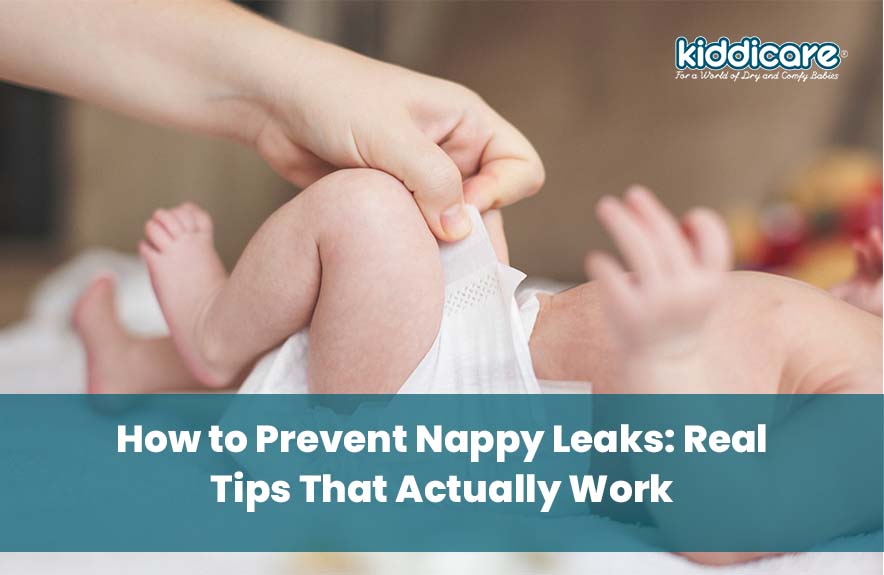There's a unique kind of silence in a New Zealand home on a cold winter's night. It's a peaceful, cosy feeling, often broken only by the gentle breathing of a sleeping baby. But then, a faint fussing sound begins. You go to check on your little one, lift them from their cot, and you feel it: the dreaded damp patch spreading across their sleepsuit.
Another leak.
If this scenario sounds familiar, you're not alone. After two decades of writing for and speaking with Kiwi parents, I can tell you that nappy leaks are a universal frustration. They mean more laundry, disrupted sleep, and an uncomfortable baby. But they don't have to be your reality. Stopping leaks for good isn't about luck; it's about technique. This is your complete guide to achieving dry days and peaceful nights.
Why Nappies Leak: The Main Causes
Before we get to the solutions, it's crucial to understand the culprits. In my experience, leaks almost always come down to one of these five common issues:
-
The Nappy is the Wrong Size: This is the number one reason for leaks. A nappy that's too small lacks the absorbent capacity needed, while one that's too big will have gaps around the legs and waist – perfect escape routes for wetness.
-
The Fit Isn't Secure: Even the right size nappy will fail if it isn't put on correctly. Loose tabs, a saggy waistband, or tucked-in leg cuffs are an open invitation for a mess.
-
Low Absorbency for the Situation: Not all nappies are created equal. A standard daytime nappy might not have the capacity to handle a 12-hour overnight stretch.
-
Compression from Bulky Winter Layers or Sleep Sacks: On a chilly NZ night, we bundle our babies in warm layers. However, snug clothing, sleep sacks, or even car seat straps can squeeze a whole nappy, forcing liquid out the sides.
-
Baby's Sleeping Position: Babies are active sleepers! Tossing and turning can cause a nappy to shift, creating gaps, especially for tummy sleepers.
The 5-Step Checklist for a Leak-Proof Nappy
Now for the good part: the tried-and-true methods that will transform you into a leak-stopping expert. Follow these five steps every single time you change a nappy.
Step 1: Find the Perfect Size
Forget brand loyalty for a moment and focus on the weight chart. Every nappy pack, from Huggies to Rascal + Friends to Treasures, has a weight guide. If your baby is nearing the top end of a size range (e.g., 10 kg in a 6-11 kg size), it's often time to size up, even if they technically still fit. For a quick check, you should be able to fit two fingers under the waistband comfortably. If it's any tighter, it's too small.
Step 2: Master the Fit
This is where technique truly matters. First, ensure the Nappy is centred under your baby before fastening the tabs symmetrically. The absolute golden rule, however, involves the leg cuffs. These are the frilly bits around the leg openings. After the Nappy is on, run your finger around each leg hole to ensure these cuffs are flared outwards, not tucked in. They are your primary barrier against leaks, so make sure they're doing their job.
Step 3: Choose the Right Nappy Type
Think of nappies like you think of tyres, you need the right kind for the conditions. A standard, slim-fit Nappy is perfect for daytime running around. But for the long haul of an overnight sleep, you need something with more power. Invest in a box of high-absorbency overnight nappies. They contain more absorbent material and are specifically designed to last up to 12 hours, giving everyone a better chance at a whole night's sleep.
Step 4: A Key Tip for Baby Boys
This is a simple trick that has saved countless parents from frustration. When putting on a fresh nappy for a baby boy, take a moment to ensure you point his penis down into the Nappy. If it's pointing up or to the side, the urine stream can be aimed directly at the waistband or leg gaps, bypassing the absorbent core entirely and causing an instant leak.
Step 5: Change the Nappy on Time
A nappy can only hold so much. While modern designs are incredibly absorbent, they have their limits. For newborns, a change is needed every 2-3 hours. For older babies, keep an eye on the wetness indicator strip, that handy line that changes colour when wet. If the nappy feels heavy or swollen or is sagging, it's definitely time for a fresh one. A proactive change is always better than a reactive cleanup.
Special Tips for Tricky Situations
How to Stop Leaks Overnight
To survive a long winter's night, combine our tips: Use a dedicated, high-absorbency overnight nappy, consider going up one size for extra capacity, and do one final change right before you go to bed yourself. This "dream change" ensures your baby starts the longest stretch of sleep with the freshest, most absorbent nappy possible.
Eco & Reusable Nappy Tips
For those using modern cloth nappies (MCNs) or other eco-friendly options, fit is paramount. Ensure the leg elastics sit snugly in the underwear line. The secret to success, especially overnight, is boosting. Add extra absorbent inserts (usually made of bamboo or hemp) to give the nappy the capacity it needs to last the distance.
Preventing "Poo-namis" and Blowouts
The dreaded up-the-back blowout is often a fit issue. Make sure you pull the back of the nappy up nice and high, creating a good seal. A snug fit around the waist and properly flared leg cuffs will contain almost anything your baby can throw at it.
Summary: Your Quick Recap for Drier Nights
Becoming leak-proof is a process of small, consistent checks. By focusing on the four pillars of success: Check Size > Perfect Fit > Choose Type > Change on Time, you can dramatically reduce leaks, laundry, and late-night frustrations.
What makes Kiddicare Premium Nappies different?
While the tips above will improve the performance of any nappy, starting with superior technology makes all the difference. We developed Kiddicare Premium Nappies specifically to address the root causes of leaks, giving Kiwi parents peace of mind.
Our design focuses on three key areas:
-
Rapid-Absorption Core: Our unique 3D core technology instantly pulls wetness away from your baby's skin and locks it deep inside, preventing the surface wetness that can be squeezed out by compression.
-
Contoured, Gap-Free Fit: We use an ultra-soft, thick waistband and extra-tall, feather-soft leg guards that gently contour to your baby's shape. This creates a comfortable, effective seal that moves with your baby, preventing gaps even during active play and sleep.
-
Sustainable & Gentle Materials: Made with sustainably sourced, plant-based fluff pulp and a breathable, hypoallergenic top layer, our nappies are kind on your baby's sensitive skin and on the planet.
With Kiddicare, you're not just buying a nappy; you're investing in drier nights and happier mornings.




